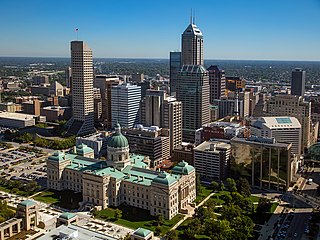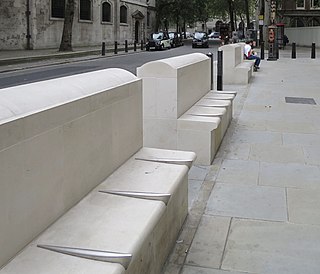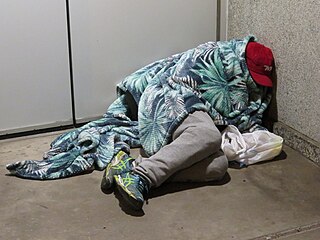Related Research Articles

Indianapolis, colloquially known as Indy, is the capital and most populous city of the U.S. state of Indiana and the seat of Marion County. According to the U.S. Census Bureau, the consolidated population of Indianapolis and Marion County was 977,203 in 2020. The "balance" population, which excludes semi-autonomous municipalities in Marion County, was 887,642. It is the 15th most populous city in the U.S., the third-most populous city in the Midwest, after Chicago and Columbus, Ohio, and the fourth-most populous state capital after Phoenix, Arizona, Austin, Texas, and Columbus. The Indianapolis metropolitan area is the 33rd most populous metropolitan statistical area in the U.S., with 2,111,040 residents. Its combined statistical area ranks 28th, with a population of 2,431,361. Indianapolis covers 368 square miles (950 km2), making it the 18th largest city by land area in the U.S.

In the United States, the number of homeless people varies from different federal government accounts. In 2014, approximately 1.5 million sheltered homeless people were counted. In 2018, the Department of Housing and Urban Development estimated roughly 553,000 homeless people in the United States on a given night, or 0.17 percent of the population. Approximately 65 percent of people were sheltered in provided housing while 35 percent were unsheltered. Annual federal HUD reports contradict private state and local reports where homelessness is shown to have increased each year since 2014 across several major American cities, with 40 percent increases noted in 2017 and in 2019.

Homeless shelters are a type of homeless service agency which provide temporary residence for homeless individuals and families. Shelters exist to provide residents with safety and protection from exposure to the weather while simultaneously reducing the environmental impact on the community. They are similar to, but distinguishable from, various types of emergency shelters, which are typically operated for specific circumstances and populations—fleeing natural disasters or abusive social circumstances. Extreme weather conditions create problems similar to disaster management scenarios, and are handled with warming centers, which typically operate for short durations during adverse weather.
Supportive housing is a combination of housing and services intended as a cost-effective way to help people live more stable, productive lives, and is an active "community services and funding" stream across the United States. It was developed by different professional academics and US governmental departments that supported housing. Supportive housing is widely believed to work well for those who face the most complex challenges—individuals and families confronted with homelessness and who also have very low incomes and/or serious, persistent issues that may include substance use disorders, mental health, HIV/AIDS, chronic illness, diverse disabilities or other serious challenges to stable housing.

Out of 10,000 female individuals 13 are homeless. Although studies reflect that there are many differences among women suffering homelessness and there is no universal experience, the average homeless woman is 35 years old, has children, is a member of a minority community, and has experienced homelessness more than once in their lifetime.

Saint Francis House is a nonprofit, nonsectarian, daytime shelter, primarily for the homeless, located in downtown Boston, Massachusetts, and founded in the early 1980s. It is the largest daytime shelter in New England and serves as an early model of such a center.
Housing First is a policy that offers unconditional, permanent housing as quickly as possible to homeless people, and other supportive services afterward. It was first discussed in the 1990s, and in the following decades became government policy in certain locations within the Western world. There is a substantial base of evidence showing that Housing First is both an effective solution to homelessness and a form of cost savings, as it also reduces the use of public services like hospitals, jails, and emergency shelters. Cities like Helsinki and Vienna in Europe have seen dramatic reductions in homelessness due to the adaptation of Housing First policies, as have the North American cities Columbus, Ohio, Salt Lake City, Utah, and Medicine Hat, Alberta.

Downtown Indianapolis is a neighborhood area and the central business district of Indianapolis, Indiana, United States. Downtown is bordered by Interstate 65, Interstate 70, and the White River, and is situated near the geographic center of Marion County. Downtown has grown from the original 1821 town plat—often referred to as the Mile Square—to encompass a broader geographic area of central Indianapolis, containing several smaller historic neighborhoods.

Homelessness or houselessness – also known as a state of being unhoused or unsheltered – is the condition of lacking stable, safe, and functional housing. The general category includes many disparate situations, including:

Discrimination against homeless people is the act of treating homeless people, or people perceived to be homeless, unfavourably. As with most types of discrimination, it can manifest in numerous forms.

The San Francisco Bay Area comprises nine northern California counties and contains four of the ten most expensive counties in the United States. Strong economic growth has created hundreds of thousands of new jobs, but coupled with severe restrictions on building new housing units, it has resulted in an extreme housing shortage which has driven rents to extremely high levels. The Sacramento Bee notes that large cities like San Francisco and Los Angeles both attribute their recent increases in homeless people to the housing shortage, with the result that homelessness in California overall has increased by 15% from 2015 to 2017. In September 2019, the Council of Economic Advisers released a report in which they stated that deregulation of the housing markets would reduce homelessness in some of the most constrained markets by estimates of 54% in San Francisco, 40 percent in Los Angeles, and 38 percent in San Diego, because rents would fall by 55 percent, 41 percent, and 39 percent respectively. In San Francisco, a minimum wage worker would have to work approximately 4.7 full-time jobs to be able to spend less than 30% of their income on renting a two-bedroom apartment.
Homeless veterans are persons who have served in the armed forces who are homeless or living without access to secure and appropriate accommodation.

Safe Horizon, formerly the Victim Services Agency, is the largest victim services nonprofit organization in the United States, providing social services for victims of abuse and violent crime. Operating at 57 locations throughout the five boroughs of New York City. Safe Horizon provides social services to over 250,000 victims of violent crime and abuse and their families per year. It has over 800 employees, and has programs for victims of domestic violence, child abuse, sexual assault, and human trafficking, as well as homeless youth and the families of homicide victims. Safe Horizon's website has been accessible for the Spanish-speaking population since 2012. Safe Horizon has an annual budget of over $63 million.

The Ali Forney Center (AFC), based in New York City, is the largest LGBT community center helping LGBTQ homeless youth in the United States. The AFC both manages and develops transitional housing for its clients. AFC helps approximately 2,000 youth clients each year, primarily between sixteen and twenty-four years old. AFC is named after Ali Forney, a transgender youth who was murdered in New York in 1997.

Homelessness in the United States has occurred to varying degrees across the country. The total number of homeless people in the United States fluctuates and constantly changes hence a comprehensive figure encompassing the entire nation is not issued since counts from independent shelter providers and statistics managed by the United States Department of Housing and Urban Development vary greatly. Federal HUD counts hover annually at around 500,000 people. Point-in-time counts are also vague measures of homeless populations and are not a precise and definitive indicator for the total number of cases, which may differ in both directions up or down. The most recent figure for the year 2019 that was given was at 567,715 individuals across the country that have experienced homelessness at a point in time during this period.

Homelessness is a growing problem in Colorado and is considered the most important social determinants of health. Homelessness is very difficult for many Coloradoans to escape due to the continuous increase in costs for housing in Colorado along with mental health treatments and other factors. When people are forced to live without stable shelter, they are then exposed to a number of risk factors that affect physical and mental health. Although it is difficult to pin point any one cause of homelessness, there is a complicated combination of societal and individual causes.

The United States Department of Housing and Urban Development estimated that more than 171,500 people were experiencing homelessness in California in January 2022. This represents 30% of the homeless population of the United States. More than two-thirds of homeless people in California are unsheltered, which is the highest percentage of any state in the United States. Half of the unsheltered homeless people in the United States live in California: about 115,500 people, which is nine times as many as the state with the second highest total.
Covenant House Toronto is a nonprofit organization that serves, at-risk, homeless and trafficked youth between the ages of 16 and 24. It is based in Toronto, Ontario, Canada and is one of many Covenant House locations based in North America. The Toronto location is the largest agency of its kind in Canada, with 80 per cent of their annual funding coming from donors. The house serves as many as 300 youth a day regardless of their race, religion, sexual orientation, gender identity, or the circumstances that have brought them to their doors. Covenant House also offers services such as education, after-care, counseling, health care, employment assistance, and job training. The organization has also offered their services to more than 95,000 young people since its start in 1982.
Mass and Cass, also known as Methadone Mile or Recovery Road, is a tent city located at and around the intersection of Melnea Cass Boulevard and Massachusetts Avenue in Boston, Massachusetts. It has been characterized as "the epicenter of the region's opioid addiction crisis." It is located in the area of Newmarket, an industrial part of Boston that includes some of Dorchester, South Boston, Roxbury, and the South End.
Inner City Health Associates (ICHA) is Canada's largest community healthcare organization for unhoused people and is based in Toronto.
References
- ↑ Gilmer, Maureen C. (19 November 2014). "Teen Gets Assist From Reggie Wayne to Help Homeless". Indy Star. Retrieved 22 July 2015.
- ↑ Monroe, Howard (19 June 2014). "Indy's Horizon House Continues to Help Homeless". Wish TV. Retrieved 22 July 2015.
- ↑ "First-of-Its-Kind Health Center for Homeless Opens Indianapolis". ABC Indianapolis. 19 June 2014. Retrieved 22 July 2015.
- ↑ Yam, Kimberly (29 January 2015). "Homeless Man Who Refused to Leave His Dog During Below-Zero Temperatures Gets Shelter For Pup". The Huffington Post. Retrieved 22 July 2015.